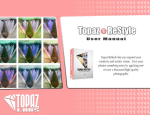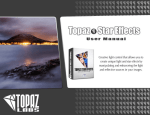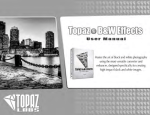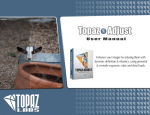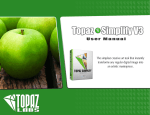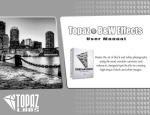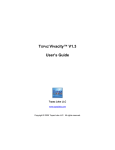Download User Manual - Topaz Labs
Transcript
Topaz Clarity User Manual I. Installation A. How to Install B. Entering Your Key C. Host-Specific Installation 1. Paint Shop Pro 2. Photo Impact 3. Irfanview D. Uninstalling 3 3 3 4 5 6 7 II. Introduction A. About Topaz Clarity B. Main Features D. Advanced Masking . E. Masking Tools F. Collections G. Presets 8 9 10 11 13 14 III. Work Area A. Interface B. Preview C. Effects & Presets 1. Adding Presets 2. Deleting Presets 3. Favorites 4. Snapshots 5. Importing Presets 6. Exporting Presets 7. Sharing Presets D. Tools E. Menu 1. Preferences 2. Check for Update 3. Enter Key 4. What’s This? 19 23 25 26 26 26 26 27 27 27 28 29 29 29 30 30 5. User Guide 6. Tech Support 7. Product Info 8. Gallery 9. MyTopaz 10. Tutorials 11. About 30 30 30 30 30 30 30 IV. Settings & Parameters A. Clarity - Dynamics B. Clarity - Tone Level C. Hue/Sat/Lum 31 32 33 VII. Additional Resources A. Shortcut Keys B. FAQ’s C. Connect D. Company Info 35 36 38 39 2 Installation Topaz Clarity User Manual Topaz Clarity is a plug-in, which means it won’t run by itself and requires a compatible host program for use. To Install in Photoshop 1. Close Photoshop or other image editing program if you are using it. 2. Double-click on the Topaz Clarity folder to access the installer, and then follow the on-screen instructions. Entering Your Key Entering your trial key allows you to save your projects and print them during your evaluation period. Entering your license key allows you do the same, except without any time limitations. 1. Start by opening up an image in Photoshop. 2. Go to Filters -> Topaz Labs -> Clarity -> Menu -> Enter key. 3. You can then copy and paste or type your key in. Important: To install the product on a second computer, you will need to download Topaz Clarity and then enter your same license key. Mac dmg Windows exe 3. Your Topaz Clarity plug-in will automatically be installed in your Photoshop plug-ins folder. 4. After the installation, you will need to enter your license or trial key. Important for Mac Users: After installation, Topaz Clarity will be installed in the following folder: “ Macintosh HD -> Library -> Application Support -> Topaz Labs -> Clarity”. If your Photoshop is installed in a customized location, you will need to manually create a shortcut (alias) link inside folder “<Photoshop install folder> -> Plug-ins” that links to “ Macintosh HD -> Library -> Application Support -> Topaz Labs -> Clarity -> Plug-ins”. Host-Specific Installation Topaz Clarity is also compatible with Lightroom, Aperture and iPhoto. To use Clarity in any of these programs you will need to download and install the free Topaz Fusion Express compatibility add on. You can get it online at: www.topazlabs.com/downloads In Windows, Topaz Clarity is supported by most host applications that support Photoshop plug-ins. This includes Paint Shop Pro, Photo Impact and Irfanview, although there are additional host programs that may also support Topaz Clarity. To install Clarity in either Paint Shop Pro, Photo Impact, or Irfanview first download Topaz Clarity to the default location. Then, to configure it into each program, follow the host-specific instructions on the next page. 3 Topaz Clarity User Manual How to install Topaz Clarity in Paintshop Pro 1. First launch PaintShop Pro / Photo Impact. Installation 3. Choose C: \ Program Files \ Topaz Labs \ Topaz Clarity\ Plugins and click “OK”. 2. Go to Menu file -> Preferences -> File Locations. Select “Plug-ins” from the “File Types” list and click “Add”. 4 4. Topaz Clarity is now available to use. Simply go to Effects -> Plug-ins and select “Clarity”. Topaz Clarity User Manual How to install Topaz Clarity in Photo Impact 1. First launch Photo Impact. 2. Go to File -> Preferences -> General or use shortcut key F6. Installation Then click on the button and browse to find the Clarity plug-in folder located in: C:\Program Files\Topaz Labs\Topaz Clarity plug-ins and click “OK”. 4. Restart Photo Impact. Go to Menu -> Effect to access the plug-in. 3. Select Plug-ins from the Categories list. 5 Topaz Clarity User Manual How to install Topaz Clarity in Irfanview 1. Make sure that you have downloaded and installed the 8bf plug-in add-on, available on the Irfanview webpage. (http://www.software.com/irfanview-plugin) Installation 3. In the screen that pops up, select “Add 8BF filters” and navigate to the C:\Program Files\Topaz Labs\ Topaz Clarity \Plug-ins folder and click “OK”. You will then see “Topaz Clarity” in the Available/Loadable 8BF Filters section. 6 2. Open Irfanview and go to Image -> Effects -> Adobe 8BF filters. 4. To use Topaz Clarity in the future, simply go to Image -> Effects> Adobe 8BF filters again and select “Topaz Clarity”. Uninstalling Topaz Clarity User Manual To uninstall Topaz Clarity follow these instructions: Mac 1. Quit Photoshop (or other editing program). 2. Navigate to the Topaz Labs support files and frames located at: Macintosh HD -> Library -> Application Support -> Topaz Labs. 3. Locate the Topaz Clarity folder and move it to the trash. You will need to enter your system password to OK this change. 4. Navigate to your Photoshop plug-ins folder located at: Applications -> Photoshop -> Plug-ins 5. Locate any leftover Topaz Clarity files and move it to the trash. 3. Select Programs, then Uninstall a Program. 4. Select Topaz Clarity and click remove. Windows 7* 1. Quit Photoshop (or other editing program). 2. Click on the Start Menu and select Control Panel -> Programs -> Programs and Features. 3. Select Topaz Clarity and click uninstall. *Please note that if you also have the 64-bit version of Clarity installed, then you will need to first uninstall this version before you can uninstall the regular version. Windows XP* 1. Quit Photoshop (or other editing program). 2. Click on the Start Menu and select Control Panel. 3. Double-click on Add / Remove programs. 4. Select Topaz Clarity and click remove. Windows Vista* 1. Quit Photoshop (or other editing program). 2. Click on the Start Menu and select Control Panel. Before After 7 Topaz Clarity User Manual Introduction Topaz Clarity Flawless Image Definition Topaz Clarity is the ultimate tool to create compelling and powerful images by intelligently enhancing contrast and clarity with absolutely no artifacts or halos. With just a few clicks you can easily manipulate your micro, mid-tone and overall contrast, transforming your image from flat to vibrant, all while maintaining a natural quality and tonality. Traditionally, photographers who wanted to boost clarity while retaining the full tonal range, had to choose between sacrificing image quality with quick adjustments or making a series of painstaking and time consuming adjustments. The cutting-edge technology inside Topaz Clarity eliminates this problem by giving photographers the ability to quickly produce images that are both vibrant and high quality. Before - By Topaz User Steve Huskisson Visit the Clarity Gallery to see more examples: gallery.topazlabs.com/Photography/Topaz-Clarity After - By Topaz User Steve Huskisson 8 Topaz Clarity User Manual Introduction Main Features The Primary Features of Topaz Clarity Include: 1. Selective Contrast Control. Use a cutting-edge process to select specific contrast variations in your original image, allowing you to quickly target and then increase or decrease the contrast and clarity in that specific variation. 2. Breakthrough Halo-Free Algorithm. Boost contrast and clarity without emphasizing transitions between light and dark areas, eliminating the common problem of halos, noise and artifacts. 3. Advanced Hue/Saturation/Luminance Technology. Using IntelliColor technology, you can easily enhance your image with the HSL filter, getting stronger, yet more natural HSL adjustments. Before - By Topaz User Steve Rich 4. Re-Imagined Masking Workflow. The masking module, now attached to each adjustment tab contains a comprehensive set of tools including an edge-aware brush, gradient mask, smart feather tool, color aware tool and more. 5. User Interface Design. With Clarity, we have continued to develop a cleaner, more modern and efficient interface to improve usability, workflow and overall aesthetics. After - By Topaz User Steve Rich 9 Features Topaz Clarity User Manual Advanced Masking Topaz Clarity introduces a new masking workflow designed to help you easily and effectively achieve selective adjustments. Additionally, each adjustment module now has an individual mask attached. 1. Reveal/Hide Option Choose which color you would like paint with: white (reveal) or black (hide). If you are masking on a white mask, you’ll want to start with a black brush color and vice versa. 1 2 2. Undo/Redo/Invert/Reset From the left: Undo and redo your steps, invert your mask colors and reset all values to a white (reveal) mask. 3. Brush and Gradient Tools 4 10 3 Switch between a brush or gradient tool to create our mask. The brush tool has 3 different brushes: normal, edge aware and color aware. The gradient tool can create 3 different types of gradients: linear, radial and reflective. 4. Sliders/Tool Options Controls the masking tool selected using sliders and buttons to adjust the available settings. This area will change with each tool. 5 5. Refining Options Use the Color Range and Smart Feather adjustments to refine or even create your mask. The mask view allows you to see the areas where your selective adjustments are being applied in your image. Features Topaz Clarity User Manual Masking Tools Along with a new masking workflow, several new masking tools are introduced in Topaz Clarity alongside some of our redesigned tools. Brush Tool The brush tool has 3 different brushes to choose from: normal, edge aware and color aware. Strength Controls the strength of the brush value being applied. At 1, the strength is 100% and will apply at the strongest value of the brush....at lower values it will only apply a percentage of the strength each time. Brush Size Controls the size of the brush. Hardness Controls the edge hardness of the brush. A value of 0 is 100% hard, while a value of 1.00 is 100% soft. The normal brush is a standard brush controlled by the sliders below. The edge aware brush is a smart brush that detects the edges of the area you are masking. Just keep the cross hairs of your brush on the area/color you want to effect and the brush will not bleed into any other areas. The color aware brush uses the same technology as the edge aware brush, but gives you a color picker instead of having to keep your cross hairs in the area you are masking. Just click the color picker icon, select a color in your image that you’d like to mask, then brush away without fear of going into another color. You can continue to select colors during your masking session. Preset The A/B presets allow you to create more than one size/type brush so you can quickly switch back and forth. Gradient Tool The brush tool has 3 different gradients to choose from: linear, radial, reflective. Just click and drag in your image to create the gradient. Linear Gradient The gradient follows a line. Radial Gradient The gradient radiates from a defined point Reflected Gradient 11 Features Topaz Clarity User Manual Color Range The Color Range tool selects a specified color within an image and creates a mask based upon that color. To use the Color Range tool, click on the button within the mask module, then select the color in your image that you would like to mask out (the green dot lets you know which color is selected). Smart Feather The Smart Feather tool blurs the edges of the mask to create a softer transition between the masked and unmasked areas. Feather Radius Determines the size of the feathered edge. Use a small radius for harder edged, and a large one for softer edges. Feather Aware Controls how edge aware the feathered area is. Higher values increase awareness, which is good for precise yet natural transitions. Lower values indicate less awareness, allowing for a more soft and blurred transition. Mask Contrast Determines the edge brightness of the mask. Increasing this parameter will give the mask edges more detail and definition. Size Controls the size of the area effected by the Color Range selection. Sensitivity Adjust the range of the color selected using the Sensitivity slider. Set a high Sensitivity value to restrict the color range to only the selected color, a lower value to increase the range. Mask Strength Determines how hard your mask is applied to subject edges in your image. The higher the parameter the harder your edges will be. The lower the parameter, the softer your edges will be. 12 Topaz Clarity User Manual Collections The Collections menu features 9 default and 2 user collections which helps to manage your user-made presets - there’s over 100 default presets included in Topaz Clarity. Each Collection features a set of its own presets that can be applied to your image. During your workflow you can select the type of effects that you want and then choose from one of the included presets in that collection. Features As in the other Topaz programs, you also have a presets panel. You can create and save your own presets. You also have the ability to export and import presets - allowing you to share with your friends. * Default presets that come with the program can not be deleted. 13 Collections can be added by clicking on the small gear icon on the upper right of the collections panel. You can Add, Delete or Rename your user collections. Features Topaz Clarity User Manual Presets There are over 100 carefully crafted preset in Clarity to choose from. These one-click effects were specially developed and fine-tuned for specific types of photos including architecture, documentary, fashion, general, landscape, macro, nature, portrait, and wedding. Architecture Collection Features presets that have been created for and tested on architecture images. 14 Original Image Brick Building I Preset Features Topaz Clarity User Manual Documentary Collection Features presets that have been created for and tested on documentary images. Fashion Collection Features presets that have been created for and tested on fashion images. 15 Original Image Original Image Desaturated Grunge I Preset Contrast Boost - Edgy I Preset Features Topaz Clarity User Manual General Collection Features presets that have been created for and tested on various types of photographic images. Landscape Collection Features presets that have been created for and tested on landscape images. 16 Original Image Original Image Contrast and Color Boost I Preset Low Contrast and Color Pop II Preset Features Topaz Clarity User Manual Macro Collection Features presets that have been created for and tested on macro images. Nature Collection Features presets that have been created for and tested on nature and wildlife images. 17 Original Image Flower II Preset Original Image Dramatic Contrast and Color I Preset Features Topaz Clarity User Manual Portrait Collection Features presets that have been created for and tested on portrait and lifestyle images. Wedding Collection Features presets that have been created for and tested on wedding and event images. 18 Original Image Original Image Portrait III Preset Soft Colors Preset Work Area Topaz Clarity User Manual Interface (Main View) Although the Topaz Clarity interface may look intimidating at first glance, don’t worry: it’s actually quite simple and easy to use. You’ll soon be a pro after experimenting with it for a bit. In order to make sense of the function of each of the various controls, we have divided the interface into a few sections: 3 1 4 2 19 5 1. Presets/Effects Panel 2. Preview Window 3. Viewing Tools 4. Navigator Panel 5. Settings & Parameters Pre-defined presets, organized by type of effect.. Displays the preview of the original and adjusted image. Tools that control zoom, split screen view, background color and more. Tabs to view the preview navigator, loupe, mask and histogram information. Quick buttons and sliders to adjust the various effects. Topaz Clarity User Manual Work Area Interface (Tool Panel View) Use the small arrow on the upper left of the interface to expand and collapse the preset panel. You can click the arrow or grab the inside edge of the panel and drag it in or out. 20 Topaz Clarity User Manual Work Area Interface (No Panel View) Use the small arrow on the upper corners of the interface to expand and collapse the preset and tool panels. You can click the arrows or grab the inside edge of the panels and drag them in or out. 21 Topaz Clarity User Manual Work Area Interface (Preset Panel View) Use the small arrow on the upper right of the interface to expand and collapse the preset panel. You can click the arrow or grab the inside edge of the panel and drag it in or out. 22 Topaz Clarity User Manual Preview Section The Preview section is the main window that is centered in the Clarity interface. The preview section shows you the original image and the processed preview of the image. Click on the image in the preview window (or use the and buttons) to switch and compare the filtered and unfiltered images. Use the buttons to switch between the processed view and the split screen (before/after). Work Area To pan the preview image, click and hold the space bar and hold the mouse button on the preview image and drag it around. When you let go of the mouse button, the new portion of the image will be processed and the result will be displayed. You can also use SPACE bar or your numbered shortcut keys “1” and “2” to switch back and forth between your filtered and unfiltered image in the preview window. 23 Work Area Topaz Clarity User Manual You can zoom in or out of the preview image by clicking the “+”, or “-” buttons above the main preview image. You can also re-size the window as well by dragging the bottom right corner in and out. The “Fit” button will fit the entire image into the preview window. The “1:1” button will zoom to 100% view. If zoomed below 100% the preview image will be internally re-sized in order to speed up preview updating. Before - By Topaz User Robyn Aber The “Ctrl +” and “Ctrl –” keys zoom in and out of the image, just like in Photoshop. A complete list of the shortcut keys can be found in the Shortcut Keys section later in this manual. Photoshop and other host software support many Image Modes, such as Grayscale, RGB, LAB, CMYK, etc. Images can also be 8, 16, or 32 bits per channel. Topaz Clarity supports both 8 bits per channel and 16 bits per channel. Clarity supports RGB mode only. To work on black-and-white images, first convert them to RGB mode. After - By Topaz User Robyn Aber 24 Work Area Topaz Clarity User Manual Presets are pre-defined settings that you can recall and reapply to any image at any time. They are a great way to speed up and simplify your workflow, and offer creative ideas. 1 We’ve included some default presets for you and, although they won’t work for every single photograph, they serve as excellent starting points. 1. Effects List 2 Lists all of the included effect collections that can be applied to your images. 3. Presets List Lists all of the available presets for the selected Effect. 25 2. Preset Options The preset options allow you to star your favorite presets, save/delete presets (default presets cannot be deleted), import/export presets for sharing, and take up to 99 “snapshots” to compare while editing. 4 3 4. Preset Preview Provides a preview of the available presets included in the Effects list selected. Scroll over the preset list to see each preview. 5. Preset QuickLook View View all of the presets in a collection at the same time by clicking the grid icon on the top right of the Presets list. 5 Work Area Topaz Clarity User Manual Adding Presets Sometimes it’s convenient to be able to define presets and save your settings for later use. To do this, first adjust the Topaz Clarity parameters until you’re satisfied with the result. Then, click on . Next, enter a preset name and description, then choose which collection to save it in (you can create a new collection here as well). To apply it later, just click it like any other preset. Snapshots A snapshot is a temporary preset provided as a workflow tool so you can temporarily save, then go back to a previous place in your session. You can take up to 99 snapshots during each session by clicking on the camera icon at the bottom right of the presets panel. Note: Snapshots are NOT SAVED and will be deleted after exiting the session. Please Note: If the name you’ve entered is the same as a preset you’ve already defined then you will be asked if overwrite the previous one. Deleting Presets If you’d like to delete a preset, click desired preset selected. with your Please Note: Default presents cannot be overwritten or deleted. Once you delete a preset or overwrite it, it cannot be retrieved. Favorites To add a default or user-made preset to you favorites, just click on the star next to the preset. To remove a preset, click the star while in your favorites collection. Saved presets are located in the Topaz Clarity “Presets” folder: C:\Program Files (x86)\Topaz Labs \ Topaz Clarity \ Presets unless you’ve opted to install Topaz Clarity into a different directory. Mac users have this folder at: HD / Library / Application Support/ Topaz Labs / Clarity/ Presets. 26 Topaz Clarity User Manual Importing Presets To import a preset file, click the import icon.. This will open up a “Browse” box to import a saved preset from your computer into Topaz Clarity. This is useful if you have downloaded a preset file that you’d like to use. Work Area Exporting Presets To export the preset file to a certain location, click “Export”. Name your preset and save it to your desktop or other specified location that you have reserved for saved presets. 27 You can then share this preset file with others who may then import it. Sharing Presets Feel free to share your saved presets by emailing them to your friends and having them put it into their Topaz Clarity Presets folder. Visit the Topaz Labs Blog which features the latest Photography, software and design information including tutorials, videos, and thoughts about both Topaz and non-Topaz topics: www.topazlabs.com/blog Work Area Topaz Clarity User Manual Tools 1 Use the various tools in the tool panel during your workflow to make image adjustments. 1. Navigator/Loupe/Mask/Histogram - Depending on which tab is chosen, various information will display. • The Navigator displays the region of the preview image you are currently focused on. You can drag the preview navigator box around to pan your image. • The Loupe displays the area of your image chosen at a 100% view. • The Mask tab displays the current mask applied to your image from the individual adjustment tabs. • The Histogram displays the graphical representation of the current tonal distribution in your image. 2 28 2. Sliders and Parameters/Masks - Controls the editing process using sliders to adjust the various effects and masks for each adjustment tab. To decrease the effect of each tab, use the opacity slider on each tab. 3. Undo/Redo and Reset Buttons - From the left: Undo and redo your steps, reset all sliders/values back to default settings. 3 Topaz Clarity User Manual Menu Work Area Check for Updates Checks for available Topaz Clarity updates. You can access the Topaz Clarity menu by clicking on the “Menu…” button at the bottom of the interface. Click the Show Details button to get find out what’s included in the update before you install. Preferences Select this to enable or disable the program tool tips, turn off interactive sliders and much more. 29 Topaz Clarity User Manual Enter Key Select this to enter your trial or purchased license key. Enter your name, then copy and paste your 30 digit key into the key field. Press OK to activate. Work Area Gallery Select this to open up your Internet browser and go to the Topaz Clarity image gallery to see other user images enhanced with Topaz Clarity. MyTopaz Brings you to the Topaz community where you can connect and interact with other Topaz users. Here you can also participate in discussions and contests, and share your favorite Topaz images. What’s This? Select this (or click F1) then click on a feature in the Clarity interface to learn more about it. Users Guide Select it to pull up this user guide. Tutorials Brings you to the Topaz Clarity tutorials page where you can access a variety of helpful video and text tutorials. You can also submit tutorials that you created here as well. About Select this to see what version of Clarity you currently have. Tech Support Brings you to the Topaz Labs support page where you can request assistance from our support specialists, contact our customer service team, retrieve lost license keys, or browse through our Knowledge Base. Product Info Select this to go to the Topaz Clarity web page to learn more about the Topaz Clarity plug-in. To connect with other Topaz users, participate in Topaz contests and to see the latest tips, tricks and tutorials sign up for the new Topaz Forum online at: www.topazlabs.com/forum 30 Topaz Clarity User Manual Settings & Parameters Clarity The Clarity module breaks the image down into specific contrast variations, allowing for maximum control over micro, mid-tone, and overall contrast. In addition, the module allows the user to adjust white and black levels to ensure details in the highlight and shadow areas are preserved. Dynamics The Dynamics group allows you to selectively adjust contrast in your image, and refers to the original image contrast variations allowing you to increase or decrease the contrast in that specific variation. The highlight of this module is the ability to adjust mid-tone contrast quickly and easily, something that would normally take many steps to achieve. After - By Topaz User Joseph Muench Micro Contrast Targets micro (very small) contrast variations, allowing you to increase or decrease the contrast in this specific variation. Low Contrast Targets low (shorter midtones) contrast variations, allowing you to increase or decrease the contrast in this specific variation. Medium Contrast Targets medium (midtones) contrast variations, allowing you to increase or decrease the contrast in this specific variation. High Contrast Targets large (shadows and highlights) contrast variations, allowing you to increase or decrease the contrast in this specific variation. 31 Topaz Clarity User Manual Settings & Parameters Tone Level Adjust the overall image tonal scale using the tone controls. You can correct black or white levels that may have changed after the Dynamics adjustments. Black Level Adjusts black clipping. Drag to the left to boost shadows closer to black. Drag to the right to reduce shadow clipping and recover shadow detail. Before - By Topaz User Joanne West Midtones Adjusts image brightness, mainly affecting midtones. White Level Adjusts white clipping. Drag to the left to reduce clipping in highlights and recover highlight detail. Drag to the right to boost highlights closer to white. After - By Topaz User Joanne West 32 Topaz Clarity User Manual Settings & Parameters Hue/Sat/Lum Use the Hue/Saturation/Luminance module to adjust individual color ranges in your photo. There are 8 color range sliders and an overall slider at the bottom of each group. To display which group to work in, click on the Hue, Saturation or Luminance button. Hue Changes the color. For example, you can change a red wagon (and all other red objects) from magenta to orange. Saturation Changes the color vividness. For instance, you can change a green field from gray to highly saturated green. 33 Topaz Clarity User Manual Settings & Parameters Luminance Changes the brightness of the color range Before - By Topaz User Adrian Pym After - By Topaz User Adrian Pym 34 Shortcut Keys Topaz Clarity User Manual Topaz Clarity uses some shortcut keys to speed up your workflow. Many of these keys are similar to those in Photoshop. The following keys work at all times. MAC Shortcut PC Shortcut Action Spacebar Spacebar View Original Image. Hold to pan. CMD-Shift-R CTRL-Shift-R Reset All CMD-0 CTRL-0 Zoom to Fit CMD-Shift-0 CTRL-Shift-0 Zoom to 100% CMD-ALT-0 CTRL-ALT-0 Zoom to 100% + or CMD + + or CTRL + Zoom In - or CMD - - or CTRL Zoom Out CMD -Z Ctrl - Z Undo CMD - Shift - Z Ctrl - Shift - Z Redo XXToggles between Hide/Reveal Brush / key / key Toggles between Brush A and B S S Takes a Snapshot CMD-1CTRL-1View Original Image CMD-2CTRL-2View Adjusted Image Down/Up Arrow Keys Scrolls through presets when selected. Return (enter) key Applies selected preset [ key Reduces selected slider value by 0.1 ] key Increases selected slider value by 0.1 Right/Left Arrow Keys With slider selected: .01 Adjustment Double-click slider name Resets the slider to it’s default value Mac and PC Shortcuts are the same unless indicated otherwise. 35 Topaz Clarity User Manual “I need a Topaz Clarity trial key.” Visit http://www.topazlabs.com/trials for a trial key. Please check your Spam folder because your Spam filter sometimes filters out the automated e-mail. If you need more time to evaluate, please contact us at: www.topazlabs.com/support for an extended trial key. “I can’t find Topaz Clarity in the Photoshop Filters menu.” If Photoshop was open when you installed then you will need to restart Photoshop and then you should be able to access it. If it is still not listed in your Filter menu then do the following: For Windows: Please go to your preferences menu in Photoshop and select Plug-ins. Check / enable the Additional Plug-ins Folder option then click Choose. After that, please navigate to: C: \ Program Files and select the Topaz Labs folder. Then click Choose (or it may say Save / OK) to save this back to Photoshop. Back in Photoshop click OK to save your changes, then restart Photoshop. Once Photoshop opens, go to your Filter menu and you should be able to access Topaz. For Mac: Please go to your preferences menu in Photoshop and select Plug-ins. Check / enable the Additional Plug-ins Folder option then click Choose. After that, please navigate to: Macintosh HD -> Library -> Application Support and select the Topaz Labs folder. Then click save / Frequently Asked Questions OK to save this back to Photoshop. Back in Photoshop click OK to save your changes, then restart Photoshop. Once Photoshop opens, go to your Filter menu and you should be able to access Topaz. “Do you have any Clarity tutorials?” Yes, you can visit: http://www.topazlabs.com/tutorials/ clarity for many tutorials or sign up for a free webinar at: http://www.topazlabs.com/webinars “I don’t have Photoshop, will Clarity work with my Elements, Aperture, Lightroom, iPhoto, Paint Shop Pro, Photo Impact or Irfanview?” Yes, you can use Topaz Clarity with any of the above host programs. However, to use Clarity in Aperture, Lightroom or iPhoto, you will need to download the free Topaz Fusion Express plug-in. For more information please visit: www.topazlabs.com/fusion “I already have photoFXlab/Fusion Express installed for use with my other Topaz programs but Clarity does not show up in the menus?” Clarity requires the latest version of photoFXlab and Fusion Express. You will need to download from: www. topazlabs.com/downloads and then install. After that you will be able to access and use Clarity. 36 Topaz Clarity User Manual “What are the limitations of the trial version of your software?” The only limit on the trial versions of the Topaz plug-ins is time. The free trial versions are designed to enable you to experience the full functionality of our plug-ins for a 30-day trial period. After the trial period is up, you will only be able to use the Topaz software by purchasing it. You will then receive a license key to activate the plug-in, and the trial version will automatically become the full version with no time limitations. “If I use the 30-day trial version will I need to uninstall the trial version before I upgrade to a full version?” No, the Topaz trial software is designed to be unlocked to become the full version simply by entering a license key. The full license key will be e-mailed to you immediately after you purchase the software. “Where do I enter my key?” To enter your key please open an image in Photoshop. Go to Filter -> Topaz Labs -> Clarity. Once the program opens go to Menu -> Enter Key. Then copy & paste or type in your license key and then select OK. “I had Topaz Clarity as a trial, then I purchased. How do I enter my new license key?” You can enter your new license key by opening up an image in Photoshop and go to Filter -> Topaz Labs -> Clarity -> Menu -> Enter Key. Please remove the trial key and enter your new purchased license key, then select OK and you are all set. Frequently Asked Questions “My Topaz Clarity key doesn’t work!” There are a couple of reasons why Topaz Clarity might think your key is invalid. First, make sure that your key is in the proper format. It’ll be in the format “xxxxxx-xxxxxx-xxxxxx-xxxxxxxxxxxx” and will be all numbers in 30 digits in five groups of six (no letters). Second, make sure that as you’re entering the key there is nothing in the space beforehand. This means clicking, pressing Ctrl-A, and hitting delete to make sure that absolutely nothing is in that field before you paste in the key. If it doesn’t work when you copy and paste, try typing it out, and vice versa. My Topaz filters are grayed out in the filter menu. Please make sure that you are using a 8-bit or 16-bit image that is in RGB color mode. Also, if your project includes adjustment layers please make sure that you are not on an adjustment layer. You will need to select the image layer. This will allow you to access your Topaz programs. I have a question not listed here. Please visit our knowledge base online at: http://www.topazlabs.com/support If you are not able to find the answer there then contact our support specialists online at: www.topazlabs. com/support or e-mail customer support at: help@ topazlabs.com 37 Topaz Clarity User Manual Connect with Topaz Check out our new Forum and our blog for tutorials, tips and updates from Topaz Labs! 38 Follow us on Twitter for notifications of recent news and easily get in touch with us whenever you feel like it! Find us on our Facebook page and network with other Topaz users! Participate in the entirely user-led Topaz Flickr group for a helpful and highly active community for Topaz Photoshop plug-ins! Subscribe to our YouTube channel to keep up with any newly released product video tutorials! Topaz Clarity User Manual Contact Information Topaz Labs LLC 4100 Spring Valley Road Suite 103 Dallas, TX 75244 Technical Support Visit: http://topazlabs.com/support/ E-mail: [email protected] For more information [email protected] Topaz Labs LLC, a privately owned company in Dallas, Texas, focuses on developing advanced video and image enhancement technology. With today’s widespread use of digital still cameras, digital video cameras, and HDTV, the need for highquality digital images and videos has greatly increased. Topaz Labs’ mission is to bring practical state-of-the-art image and video enhancement technology to both professionals and consumers. Copyright © 2010 Topaz Labs, LLC. All rights reserved. http://www.topazlabs.com 39 Topaz Clarity User Manual Be sure to check out the complete line up of Topaz products. Topaz Photoshop Plug-ins for digital photography. Topaz Adjust creates vibrant images that pop. Includes tools for creative exposure, detail, color and pseudo HDR. Topaz Lens Effects allows you to create bokeh, add vignettes and simulate a variety of filter, lens and specialty camera effects. Topaz B&W Effects is the most versatile black and white image converter. Designed specifically for creating and enhancing high-impact B&W images. Topaz ReMask is the quickest, easiest and best masking tool for complex masking and removing unwanted image backgrounds. Topaz InFocus offers tools for advanced sharpening and minor blur reduction to refine and improve overall image quality. Topaz Simplify is a digital art tool that makes it easy to transform digital images into works of art in just a few clicks. Topaz DeNoise offers highquality noise reduction tools that eliminate digital image noise and recover lost image detail. Topaz DeJPEG eliminates jpeg artifacts and restores optimal JPEG image integrity, helping create high-quality jpeg images. Go to http://www.topazlabs.com/downloads to get your 30-day free trial! Topaz DeNoise offers highquality noise reduction tools that eliminate digital image noise and recover lost image detail. Topaz Detail features multilevel tools for control over detail enhancement and sharpening without edge artifacts or halos. Topaz Clean features unique smoothing, edge and texture control for enhancing portraits or stylizing images. Bring the power of Topaz to your Aperture, iPhoto and Lightroom workflow with the new Fusion Express plug-in. 40








































